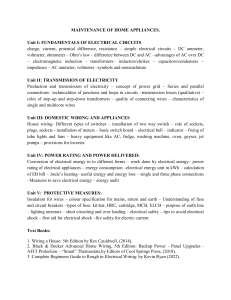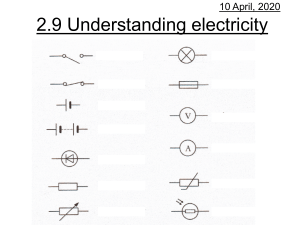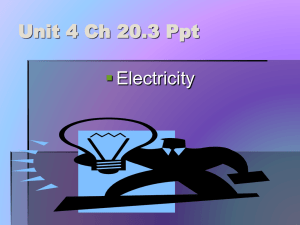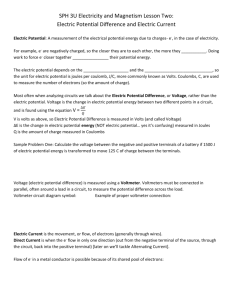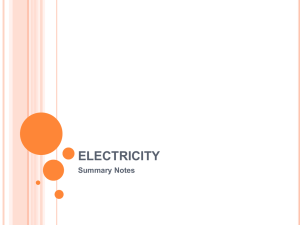9 outcomes Electricity
advertisement
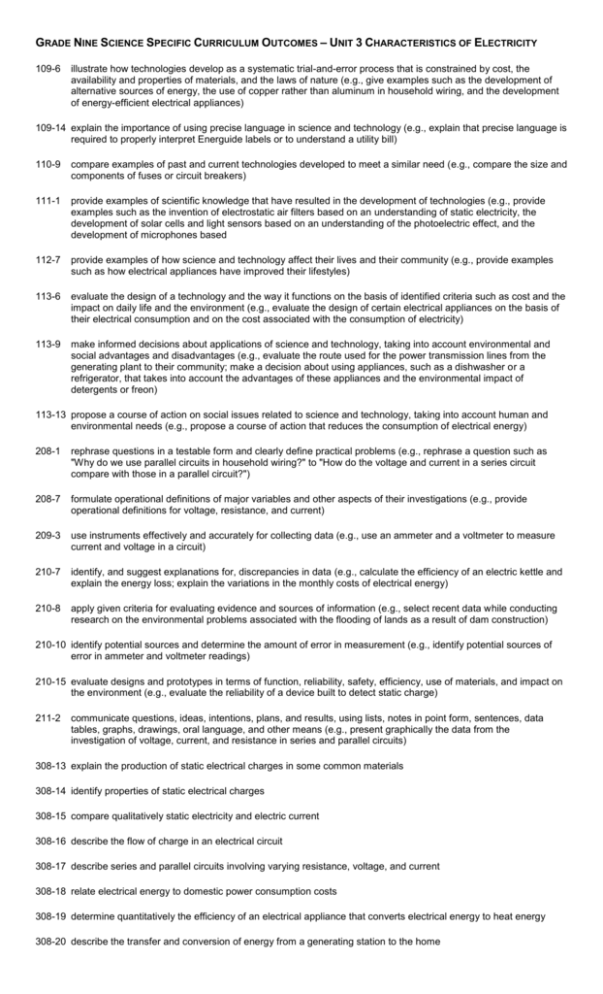
GRADE NINE SCIENCE SPECIFIC CURRICULUM OUTCOMES – UNIT 3 CHARACTERISTICS OF ELECTRICITY 109-6 illustrate how technologies develop as a systematic trial-and-error process that is constrained by cost, the availability and properties of materials, and the laws of nature (e.g., give examples such as the development of alternative sources of energy, the use of copper rather than aluminum in household wiring, and the development of energy-efficient electrical appliances) 109-14 explain the importance of using precise language in science and technology (e.g., explain that precise language is required to properly interpret Energuide labels or to understand a utility bill) 110-9 compare examples of past and current technologies developed to meet a similar need (e.g., compare the size and components of fuses or circuit breakers) 111-1 provide examples of scientific knowledge that have resulted in the development of technologies (e.g., provide examples such as the invention of electrostatic air filters based on an understanding of static electricity, the development of solar cells and light sensors based on an understanding of the photoelectric effect, and the development of microphones based 112-7 provide examples of how science and technology affect their lives and their community (e.g., provide examples such as how electrical appliances have improved their lifestyles) 113-6 evaluate the design of a technology and the way it functions on the basis of identified criteria such as cost and the impact on daily life and the environment (e.g., evaluate the design of certain electrical appliances on the basis of their electrical consumption and on the cost associated with the consumption of electricity) 113-9 make informed decisions about applications of science and technology, taking into account environmental and social advantages and disadvantages (e.g., evaluate the route used for the power transmission lines from the generating plant to their community; make a decision about using appliances, such as a dishwasher or a refrigerator, that takes into account the advantages of these appliances and the environmental impact of detergents or freon) 113-13 propose a course of action on social issues related to science and technology, taking into account human and environmental needs (e.g., propose a course of action that reduces the consumption of electrical energy) 208-1 rephrase questions in a testable form and clearly define practical problems (e.g., rephrase a question such as "Why do we use parallel circuits in household wiring?" to "How do the voltage and current in a series circuit compare with those in a parallel circuit?") 208-7 formulate operational definitions of major variables and other aspects of their investigations (e.g., provide operational definitions for voltage, resistance, and current) 209-3 use instruments effectively and accurately for collecting data (e.g., use an ammeter and a voltmeter to measure current and voltage in a circuit) 210-7 identify, and suggest explanations for, discrepancies in data (e.g., calculate the efficiency of an electric kettle and explain the energy loss; explain the variations in the monthly costs of electrical energy) 210-8 apply given criteria for evaluating evidence and sources of information (e.g., select recent data while conducting research on the environmental problems associated with the flooding of lands as a result of dam construction) 210-10 identify potential sources and determine the amount of error in measurement (e.g., identify potential sources of error in ammeter and voltmeter readings) 210-15 evaluate designs and prototypes in terms of function, reliability, safety, efficiency, use of materials, and impact on the environment (e.g., evaluate the reliability of a device built to detect static charge) 211-2 communicate questions, ideas, intentions, plans, and results, using lists, notes in point form, sentences, data tables, graphs, drawings, oral language, and other means (e.g., present graphically the data from the investigation of voltage, current, and resistance in series and parallel circuits) 308-13 explain the production of static electrical charges in some common materials 308-14 identify properties of static electrical charges 308-15 compare qualitatively static electricity and electric current 308-16 describe the flow of charge in an electrical circuit 308-17 describe series and parallel circuits involving varying resistance, voltage, and current 308-18 relate electrical energy to domestic power consumption costs 308-19 determine quantitatively the efficiency of an electrical appliance that converts electrical energy to heat energy 308-20 describe the transfer and conversion of energy from a generating station to the home



